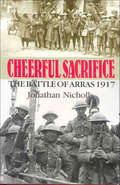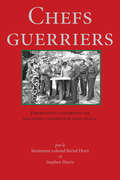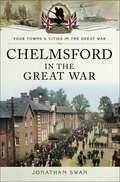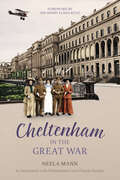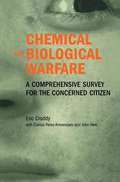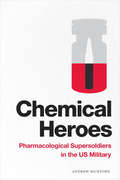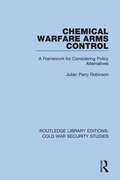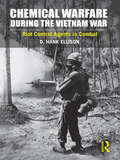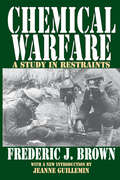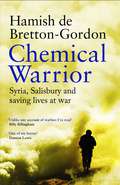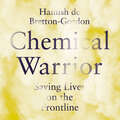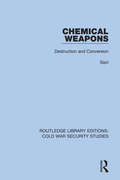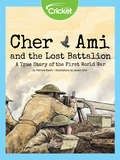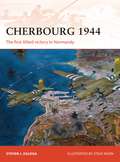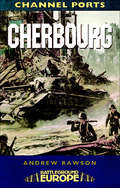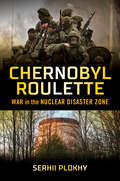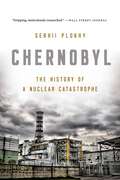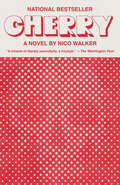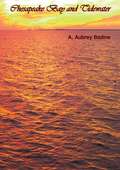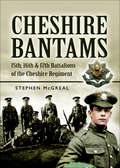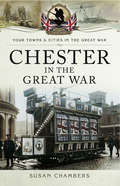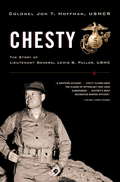- Table View
- List View
Cheerful Sacrifice: The Battle of Arras, 1917
by Jonathan NichollsThis WWI history examines the significant yet overlooked British offensive that achieved major advances on the Western Front. Fought between April 9th and May 16th of 1917, the Battle of Arras was the most lethal and costly British offensive battle of the First World War. Lasting a brutal thirty-nine days, its average casualty rate was far higher than at either the Somme or Passchendaele. It also represented the longest advance against Germany up to that point since the beginning of trench warfare. In Cheerful Sacrifice, military historian Jonathan Nicholls gives the Battle of Arras its proper place in the annals of military history, enhancing his text with a wealth of eye-witness accounts. One is left in no doubt that the survivor who described it as 'the most savage infantry battle of the war', did not exaggerate.
Chefs Guerriers
by Stephen Harris Colonel Bernd HornCe sont les hommes qui ont dirigé notre nation en temps de guerre et en temps de paix. Au cours des deux grandes guerres, ces hommes ont fait preuve d’une force à toute épreuve, qui a guidé nos troupes vers la victoire. Dans le cadre d’opérations de maintien de la paix, ils ont contribué à établir et à maintenir l’ordre. Au cours des ans, ils ont permis aux Forces canadiennes de devenir l’une des forces militaires les plus respectées au monde. <p><p> Chefs guerriers, Perspectives concernant les militaires canadiens de haut niveau est le premier d’une série de deux livres qui examine l’expérience et les perspectives uniquement canadiennes en ce qui concerne le travail des généraux et l’art d’être amiral. Le premier volume est un recueil des biographies portant sur les plus éminents militaires canadiens de la Confédération jusqu’à aujourd’hui.
Chelmsford in the Great War (Your Towns & Cities in the Great War)
by Jonathan SwanAlmost 400 men from the Chelmsford were lost in the Great War. This book explores how the experience of war impacted on the Town, from the initial enthusiasm for sorting out the German Kaiser in time for Christmas 1914, to the gradual realization of the enormity of human sacrifice the families of Chelmsford were committed to as the war stretched out over the next four years. A record of the growing disillusion of the people, their tragedies and hardships and a determination to see it through. The Great War affected everyone. At home there were wounded soldiers in military hospitals, refugees from Belgium and later on German prisoners of war. There were food and fuel shortages and disruption to schooling. The role of women changed dramatically and they undertook a variety of work undreamed of in peacetime. Meanwhile, men serving in the armed forces were scattered far and wide. Extracts from contemporary letters reveal their heroism and give insights into what it was like under battle conditions.
Cheltenham in the Great War
by Neela MannCheltenham in the Great War is the first book to portray the town, its people and the impact of the ‘war to end all wars’ from the declaration of war in 1914 to Armistice Day in 1918. Almost 1,000 Cheltenham women left by train every day for munitions work, hundreds made airplanes in the Winter Gardens, many were nurses and most former suffragettes joined the WVR. Why did two schools do double shifts and for what did the townspeople raise £186,000 in one week in 1918? How did Cheltenham cope with 7,250 soldiers billeted in the town and ‘khaki fever’? This book gives an insight into the lives of different social classes in Cheltenham – including stories of remarkable women – and how their war was fought on the Home Front. The Great War story of Cheltenham is told through considerable new research and is vividly illustrated throughout with evocative, informative images, many of which have not been published previously.
Chemical And Biological Warfare: A Comprehensive Survey For The Concerned Citizen
by Eric Croddy J. Hart C. Perez-Armendariz<P>The armaments of chemical and biological warfare (CBW), as Eric Coddy shows in this introduction for the concerned layman, are now widely held not just by nation-states, but by terrorist and criminal enterprises. The weapons themselves are relatively inexpensive and very easy to hide, and organizations of just a few dozen people are capable of deploying potentially devastating attacks with them. <P>While in the twentieth century most of our arms-control effort focused, rightly, on nuclear arsenals, in the twenty-first century CBW will almost certainly require just as much attention. This book defines the basics of CBW for the concerned citizen, including non-alarmist scientific descriptions of the weapons and their antidotes, methods of deployment and defensive response, and the likelihood in the current global political climate of additional proliferation.
Chemical Heroes: Pharmacological Supersoldiers In The Us Military
by Andrew BickfordIn Chemical Heroes Andrew Bickford analyzes the US military's attempts to design performance enhancement technologies and create pharmacological "supersoldiers" capable of withstanding extreme trauma. <P><P>Bickford traces the deep history of efforts to biologically fortify and extend the health and lethal power of soldiers from the Cold War era into the twenty-first century, from early adoptions of mandatory immunizations to bio-protective gear, to the development and spread of new performance enhancing drugs during the global War on Terrorism. In his examination of government efforts to alter soldiers' bodies through new technologies, Bickford invites us to contemplate what constitutes heroism when armor becomes built in, wired in, and even edited into the molecular being of an American soldier. Lurking in the background and dark recesses of all US military enhancement research, Bickford demonstrates, is the desire to preserve US military and imperial power.
Chemical Warfare Arms Control: A Framework for Considering Policy Alternatives (Routledge Library Editions: Cold War Security Studies #11)
by Julian Perry RobinsonThis book, first published in 1985, examines thinking around chemical weapons from the standpoint of national policy-making in a manner that integrates both defence and arms-control aspects. The process of multilateral negotiations on chemical warfare arms control is not simple, nor are the issues involved and their associated technical questions. Constraints, standards and verification are needed. This book analyses these issues, and the interplay of domestic issues and specific security requirements. This book offers an analytical framework within which a wide spread of different considerations may be located and assessed.
Chemical Warfare during the Vietnam War: Riot Control Agents in Combat
by D. Hank EllisonChemical Warfare during the Vietnam War documents the use of antipersonnel chemical weapons throughout the Vietnam War, and explores their effectiveness under the wide variety of circumstances in which they were employed. The short, readable account follows the US program as it progressed from a focus on the humanitarian aspects of non-lethal weapons to their use as a means of augmenting and enhancing the lethality of traditional munitions. It also presents the efforts of the North Vietnamese to both counter US chemical operations and to develop a chemical capability of their own. Chemical Warfare during the Vietnam War is a comprehensive and thoroughly fascinating examination of riot-control agents during the Vietnam War.
Chemical Warfare: A Study in Restraints
by Fredric BrownIn the aftermath of 9/11, the potential terror of weapons of mass destruction--from nuclear, biological, and chemical to dirty bombs--preoccupies national security experts. In Chemical Warfare, Frederic J. Brown, presents a cogent, innovative framework for understanding the historical forces that have restrained the use of WMD and how they continue to have relevance today. Analyzing both world wars, he argues that the restraints on use were complex and often unpredictable and ranged from the political to the technological. The author offers a detailed examination of American chemical warfare policy as it was shaped by industry and public sentiment, as well as national and military leaders. The organization of the book into three parts reflects the importance of battlefield experiences during the First World War and of international political restraints as they evolved during the interwar years and culminated in ""no first use"" policies by major powers in World War II. Part I examines the use of chemical weapons in World War I as it influenced subsequent national policy decisions. Part II focuses on the evolution of political, military, economic, and psychological restraints from 1919 to 1939. Part III discusses World War II during two critical periods: 1939 to early 1942, when the environment of the war was being established largely without American influence; and during 1945, when the United States faced no credible threat of retaliation to deter its strategic and battlefield use of chemical weapons. Written at the height of controversy about the U.S. use of chemicals in Vietnam, Chemical Warfare offers a valuable historical perspective, as relevant now in its analysis of chemical and also nuclear policy as it was when first published.
Chemical Warrior: Syria, Salisbury and Saving Lives at War
by Hamish de Bretton-GordonGRIPPING, MOVING AND INSPIRING: the remarkable life of a world-leading expert in chemical weapons defence."Unlike any account of warfare I've read" - Billy BillinghamFor thirty years, Hamish has served and volunteered in conflict zones around the world. As the army's foremost chemical weapons expert, he built a unique first-hand understanding of how to prevent attacks and train doctors on the frontline - saving countless lives in the process.After suffering near-death experiences time and again, Hamish discovered he had a ticking time bomb in his own chest: a heart condition called Sudden Death Syndrome that could kill him at any time. But with a new awareness for the fragility of life, he fought harder to make his count.Despite facing extraordinary personal danger, Hamish has unearthed evidence of multiple chemical attacks in Syria and continues to advise the government at the highest level, including after the 2018 Novichok poisoning in Salisbury. Lifting the lid on Hamish's unique world of battlefield expertise and humanitarian work, Chemical Warrior is a thrilling story of bravery and compassion.
Chemical Warrior: Syria, Salisbury and Saving Lives at War
by Hamish de Bretton-GordonGRIPPING, MOVING AND INSPIRING: the remarkable life of a world-leading expert in chemical weapons defence."Unlike any account of warfare I've read" - Billy BillinghamFor thirty years, Hamish has served and volunteered in conflict zones around the world. As the army's foremost chemical weapons expert, he built a unique first-hand understanding of how to prevent attacks and train doctors on the frontline - saving countless lives in the process.After suffering near-death experiences time and again, Hamish discovered he had a ticking time bomb in his own chest: a heart condition called Sudden Death Syndrome that could kill him at any time. But with a new awareness for the fragility of life, he fought harder to make his count.Despite facing extraordinary personal danger, Hamish has unearthed evidence of multiple chemical attacks in Syria and continues to advise the government at the highest level, including after the 2018 Novichok poisoning in Salisbury. Lifting the lid on Hamish's unique world of battlefield expertise and humanitarian work, Chemical Warrior is a thrilling story of bravery and compassion.
Chemical Warrior: Syria, Salisbury and Saving Lives at War
by Hamish de Bretton-GordonGRIPPING, MOVING AND INSPIRING: the remarkable life of a world-leading expert in chemical weapons defence. "His work has saved lives and given hope." - Professor David Nott, bestselling author of War Doctor For thirty years, Hamish has served and volunteered in conflict zones around the world. As the army's foremost chemical weapons expert, he built a unique first-hand understanding of how to prevent attacks and train doctors on the frontline - saving countless lives in the process. After suffering near-death experiences time and again, Hamish discovered he had a ticking time bomb in his own chest: a heart condition called Sudden Death Syndrome that could kill him at any time. But with a new awareness for the fragility of life, he fought harder to make his count. Despite facing extraordinary personal danger, Hamish has unearthed evidence of multiple chemical attacks in Syria and continues to advise the government at the highest level, including after the 2018 Novichok poisoning in Salisbury. Lifting the lid on Hamish's unique world of battlefield expertise and humanitarian work, Chemical Warrior is a thrilling story of bravery and compassion.(P)2020 Headline Publishing Group Limited
Chemical Weapons: Destruction and Conversion (Routledge Library Editions: Cold War Security Studies #12)
by SipriThis book, first published in 1980, presents the findings of the SIPRI-organized 1979 international symposium on the destruction and conversion of chemical weapons. Thirty experts from 14 countries discussed the destruction and conversion of present stockpiles of chemical warfare agents and munitions; the destruction and conversion of CW research and development facilities; verification of compliance, and confidence-building measures facilitating verification; and the environmental and occupational health hazards involved in maintaining and in disposing of stockpiles of CW agents and munitions.
Cher Ami and Major Whittlesey: A Novel
by Kathleen Rooney"Both heartbreaking and sharply funny...Cher Ami and Major Whittlesey is brilliant and surprising at every turn."—Rebecca Makkai, Pulitzer finalist for The Great BelieversA heart-tugging and gorgeously written novel based on the incredible true story of a WWI messenger pigeon and the soldiers whose lives she forever altered, from the author of Lillian Boxfish Takes a Walk. From the green countryside of England and the gray canyons of Wall Street come two unlikely heroes: one a pigeon and the other a soldier. Answering the call to serve in the war to end all wars, neither Cher Ami, the messenger bird, nor Charles Whittlesey, the army officer, can anticipate how their lives will briefly intersect in a chaotic battle in the forests of France, where their wills will be tested, their fates will be shaped, and their lives will emerge forever altered. A saga of hope and duty, love and endurance, as well as the claustrophobia of fame, Cher Ami and Major Whittlesey is a tragic yet life-affirming war story that the world has never heard. Inspired by true events of World War I, Kathleen Rooney resurrects two long-forgotten yet unforgettable figures, recounting their tale in a pair of voices that will change the way readers look at animals, freedom, and even history itself.
Cher Ami and the Lost Battalion: A True Story of the First World War
by Patricia BaehAs countries in Europe grew their military power in 1914, so did their fear of being attacked. Alliances were made and tested! Europe was split into two central powers—this was the birth of World War I. When America entered the Great War, they used carrier pigeons to send messages to their allies. Discover how one pigeon, Cher Ami, became famous for his mission to headquarters.
Cherbourg 1944
by Steven J. Zaloga Steve NoonSteven Zaloga offers up a rigorous and absorbing study of the first major Allied operation in Normandy after the D-Day landings - the capture of Cherbourg. Blending expert analysis, specially commissioned artwork and illustrative maps, this book tells the story of a quintessential example of Coastal attack and defense. Cherbourg was recognized by both The German and Allied High commands as crucial to the Allied foothold in Normandy - it was the nearest major port and was desperately needed by the Allies for major logistical operations to support their forces on long stretches of open beach. Hitler, on the other hand, declared Cherbourg to be a 'Festung' (fortress), a designation everyone knew to mean that its defenders were to fight to the last man. After a gruelling struggle involving several distinct tactical phases designed to overcome the different elements of Cherbourg's defence, the campaign resulted in a bittersweet Allied victory, the drama and significance of which are explained in full in this work.
Cherbourg: Battleground Ww2 (Battleground Europe)
by Andrew RawsonFollowing the landings in Normandy, one of the Allies main concerns was how to supply the expanding beachhead. Having cut off the Cotentin peninsula, General Bradley turned his attentions to the port of Cherbourg, the deep-water port nearest to the American landing beaches. However, Hitler had given specific orders that the port must be held until the last man. For over two weeks three divisions battled for the ring of forts surrounding the town and only after heavy casualties was the port taken. It was, however, too late, the Germans had reduced the docks to ruins.This book details this important, yet little known battle, giving a detailed and illustrated account of the events around Cherbourg in June 1944. Visitors to the area will also be able to visit the key sites on a series of tours around the peninsula.
Chernobyl Roulette: War in the Nuclear Disaster Zone
by Serhii PlokhyA harrowing account of Russia’s occupation of the Chernobyl and Zaporizhia nuclear power plants, and the dangers of nuclear power colliding with warfare. On February 24, 2022, the first day of Russia’s all-out attack on Ukraine, armored vehicles approached the Chernobyl nuclear power plant in northern Ukraine. Russian occupation of the plant, which would last thirty-five days, had begun. Only the dedication and resolve of Ukrainian personnel, who were held hostage and worked shifts for weeks instead of days, spared the world a new Chernobyl accident. They had to make life-or-death decisions on cooperation or resistance, balancing loyalty to their families, their homeland, and innocent civilians in Ukraine and beyond who would suffer the consequences of a nuclear accident should it occur. The choices they made helped to save the world from another Chernobyl disaster. Meanwhile, a much more dangerous situation developed at the Zaporizhia nuclear power plant in southern Ukraine, the largest such facility in Europe. Following an attack there in March 2022, the Russian military remains in control, and Ukrainian intelligence warns of the potential for nuclear terrorism. We must face up to a new reality: there has already been warfare at two nuclear sites, and others are vulnerable. In a book that reads like a thriller, Serhii Plokhy, a leading historian of the Cold War and Ukrainian history, joins the stories of the Russo-Ukrainian War and the Chernobyl nuclear disaster to sound the alarm about the dangers of nuclear sites in a time of heightened conflict. There are 440 such sites around the globe today, and Russia’s aggression against Ukraine will not be the last war in human history. The story of the men and women of Chornobyl is more than recent history: it is also a glimpse into the not-so-distant future.
Chernobyl: The History of a Nuclear Catastrophe
by Serhii PlokhyFrom a preeminent historian of Eastern Europe, the definitive history of the Chernobyl nuclear disaster On the morning of April 26, 1986, Europe witnessed the worst nuclear disaster in history: the explosion of a reactor at the Chernobyl Nuclear Power Plant in Soviet Ukraine. Dozens died of radiation poisoning, fallout contaminated half the continent, and thousands fell ill. In Chernobyl, Serhii Plokhy draws on new sources to tell the dramatic stories of the firefighters, scientists, and soldiers who heroically extinguished the nuclear inferno. He lays bare the flaws of the Soviet nuclear industry, tracing the disaster to the authoritarian character of Communist party rule, the regime's control of scientific information, and its emphasis on economic development over all else. Today, the risk of another Chernobyl looms in the mismanagement of nuclear power in the developing world. A moving and definitive account, Chernobyl is also an urgent call to action.
Cherry Ames, Chief Nurse (Cherry Ames #4)
by Helen WellsAfter receiving mysterious orders in Panama, Cherry is flown to a tropical island where she is assigned as a Chief Nurse candidate. But her commanding officer Colonel Pillsbee does not think she is the right person for the job due to her youth and good looks. Cherry attempts to show him that she is a good and confident nurse. Meanwhile she is put in charge of an injured flier with a mysterious wound who is not talking. Can Cherry and her brother Charlie figure out the mysterious wound and what it might mean before it is too late, and can they convince the senior officers to listen to them even if they are young? Enjoy this fourth book in the Cherry Ames Nurse series.
Cherry: A novel
by Nico WalkerJesus' Son meets Reservoir Dogs in a breakneck-paced debut novel about love, war, bank robberies, and heroin.Cleveland, 2003. A young man is just a college freshman when he meets Emily. They share a passion for Edward Albee and Ecstasy and fall hard and fast in love. But soon Emily has to move home to Elba, New York and he flunks out of school and joins the Army. <p><p>Desperate to keep their relationship alive, they marry before he ships out to Iraq. But as an Army medic, he is unprepared for the grisly reality that awaits him. His fellow soldiers smoke; they huff computer duster; they take painkillers; they watch porn. And many of them die. He and Emily try to make their long-distance marriage work, but when he returns from Iraq, his PTSD is profound, and the drugs on the street have changed. The opioid crisis is beginning to swallow up the Midwest. <p><p>Soon he is hooked on heroin, and so is Emily. They attempt a normal life, but with their money drying up, he turns to the one thing he thinks he could be really good at--robbing banks.Hammered out on a typewriter, Cherry marks the arrival of a raw, bleakly hilarious, and surprisingly poignant voice straight from the dark heart of America. <P><b>A New York Times Bestseller</b>
Chesapeake Bay and Tidewater
by A. Aubrey BodinePerfect sequel to "My Maryland," Bodine's best-selling pictorial tribute to the Free State, and his latest, "The Face of Maryland." But this is more than a sequel: it is the first published photographic documentary of the Bay. A beautiful and graphic story of the "Mediterranean of America"…its tributaries and shores which reach into Maryland, Delaware, Virginia and the District of Columbia.In more than 35 years of capturing the Bay in its many moods, Bodine has made thousands of photographs of this alluring body of water. His finest appear in "Chesapeake Bay and Tidewater.""...more than a collection of superb photographs…a book with a theme, interpreting with fidelity not only the mood but also the meaning and significance of the Chesapeake Bay country."-RACHEL CARSON
Cheshire Bantams: 15th, 16th and 17th Battalions of the Cheshire Regiment
by Stephen McGrealRaised in Birkenhead in 1914 the Bantams were unique as the average height of the volunteers was a mere five foot! Previously denied the opportunity to serve, these men seized this chance to join up. As a result the battalions comprised working class men from all over Britain Welsh miners, sturdy London dockers, Lancashire mill workers and Merseyside laborers.As part of 35th (Bantam) Division, the Bantams fought on the Somme. The Bantams casualties were so severe that by early 1917 the Division effectively ceased to exist. Thereafter reinforcements came from the General Pool. They suffered heavily again at Houlthust Forest. The 35th Division played a key part in stopping the German 1918 offensive. Some 900 members of these Battalions lost their lives in The Great War.
Chester in the Great War (Your Towns & Cities in the Great War)
by Susan ChambersAt the outbreak of the Great War, Chester was transformed from a county market town with some nice shops and lots of day-trippers, to a bustling, frantically busy military centre with men and horses everywhere. As they left for the war zones, or to go to other parts of the country for training, the city settled down to the hard work of dealing with the absence of so many men from vital jobs a challenge eventually tackled by many of the city's women. Life was hard, money was short for some, though others earned good wages in the ammunition works. It soon became obvious that many men would never come back.But life in the city went on, everyone played their part, the cinemas and theatres stayed open, as did the pubs (though with reduced hours). Concerts kept the people entertained and helped to raise vital funds, and news films kept them up-to-date with the latest from the Front. But, eventually it was over and the city had a different set of problems to deal with
Chesty
by Jon T. HoffmanThe Marine Corps is known for its heroes, and Lieutenant General Lewis B. Puller has long been considered the greatest of them all. His assignments and activities covered an extraordinary spectrum of warfare. Puller mastered small unit guerrilla warfare as a lieutenant in Haiti in the 1920s, and at the end of his career commanded a division in Korea. In between, he chased Sandino in Nicaragua and fought at Guadalcanal, Cape Gloucester, and Peleliu. With his bulldog face, barrel chest (which earned him the nickname Chesty), gruff voice, and common touch, Puller became--and has remained--the epitome of the Marine combat officer. At times Puller's actions have been called into question--at Peleliu, for instance, where, against a heavily fortified position, he lost more than half of his regiment. And then there is the saga of his son, who followed in Chesty's footsteps as a Marine officer only to suffer horrible wounds in Vietnam (his book, Fortunate Son, won the Pulitzer Prize). Jon Hoffman has been given special access to Puller's personal papers as well as his personnel record. The result will unquestionably stand as the last word about Chesty Puller.From the Hardcover edition.
